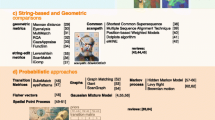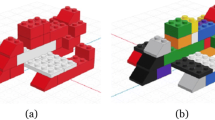Abstract
In this article, a conceptual framework developed to acquire expert knowledge from eye-tracking data of skilled individuals is presented. Domain-specific knowledge is acquired from the visual behaviour of subjects whose eye movements are recorded while solving complex visual tasks. It is argued that relevant insights into the cognitive strategies followed by the observers to solve the visual search tasks may be gained by analysing the eye-tracking data in generic feature spaces, which are at the basis of the selected scheme for knowledge representation. In this context, a feature space is a domain in which each dimension is defined as a mathematical construct, which may correspond to perceptually meaningful visual cues and which can take either numerical or categorical values. A special case of such feature spaces is the spatial domain in which the spatial coordinates of the gaze points define the dimensions of such domain. In the proposed conceptual framework, the definition of similarities between visual search patterns is essential to characterise the stereotypical visual behaviour of a group of observers, and thus expert knowledge. Furthermore, since knowledge representation is closely related to the feature domain in which the search is analysed, feature relevance measures become central to knowledge gathering, and the main aspects regarding their definition are discussed in this work. Following a detailed presentation of the conceptual framework, a practical application dealing with expert knowledge gathering in lung radiology is shown both as a proof of concept and also to illustrate a particular functional implementation of the framework.






Similar content being viewed by others
References
Bossomaier T, Snyder AW. Why spatial frequency processing in the visual cortex? Vision Res. 1986;26(8):1307–9.
Bradshaw JL. Pupil size and problem solving. Q J Exp Psychol. 1968;20(2):116–22.
Brandt SA, Stark L. Spontaneous eye movements during visual imagery reflect the content of the visual scene. J Cogn Neurosci. 1997;9:27–38.
Carpenter RHS. Movements of the eyes. London UK: Pion; 1977.
Chun MM, Wolfe, JM. Visual attention. Oxford: Blackwell; 2001. pp. 272–310.
Cox TF, Cox MA. Multidimensional scaling, 2nd edn. London: Chapman-Hall; 2001.
Daugman JG. Two-dimensional spectral analysis of cortical receptive field profile. Vision Res. 1980;20:847–56.
Daugman JG. Uncertainty relation for resolution in space, spatial frequency, and orientation optimized by two-dimensional visual cortical filters. J Opt Soc Am. 1985;A2(7):1160–9.
Dempere-Marco L. Analysis of visual search for knowledge gathering. Ph.D. thesis, Department of Computer Science, Imperial College London, London, UK, 2004.
Dempere-Marco L, Hu X, Yang GZ. Visual scan-path analysis with feature space transient fixation moments. In: Chakraborty DP, Krupinski EA, editors. Proceedings of the SPIE medical imaging 2003: Image perception, observer performance, and technology assessment conference, vol. 5034. San Diego, California, USA; 2003. pp. 503–512.
Dempere-Marco L, Hu X, Yang GZ. Low-dimensional feature domain learning from visual search. In: Abstract book of the 15th European conference on eye movements (ECEM’09). Southampton, UK; 2009.
Dempere-Marco L, Hu XP, Ellis SM, Hansell DM, Yang GZ. Analysis of visual search patterns with EMD metric in normalized anatomical space. IEEE Trans Med Imaging. 2006;25(8):1011–21.
Dempere-Marco L, Hu XP, MacDonald SLS, Ellis SM, Hansell DM, Yang GZ. The use of visual search for knowledge gathering in image decision support. IEEE Trans Med Imaging. 2002;21(7):741–54.
Edelman S. Representation is representation of similarities. Tech. Rep. E25-201, Massachusetts Institute of Technology, MIT; 1997.
Ellis S, Hu XP, Dempere-Marco L, Wells A, Yang GZ, Hansell DM. Thin section ct of the lungs: reading efficiency of tiled versus stacked display formats. Eur J Radiol. 2006;59(2):257–64.
Ellis SM. An analysis of radiologists’ assimilation of computed tomographic examinations of the lungs. Ph.D. thesis, Department of Radiology, Royal Brompton Hospital, London, UK; 2006.
Engbert R, Kliegl RR. Microsaccades uncover the orientation of covert attention. Vision Res.2003;43:1035–45
Eriksen CW, Yeh YY. Allocation of attention in the visual field. J Exp Psychol Hum Percept Perform. 1985;11(5):583–97.
Fabre-Thorpe M, Richard G, Thorpe SJ. Rapid categorization of natural images by rhesus monkeys. NeuroReport. 1998;9:303–8.
Fecteau JH, Munoz DP. Salience, relevance, and firing: a priority map for target selection. Trends Cogn Sci. 2006;10(8):382–90.
Field DJ. Relations between the statistics of natural images and the response properties of cortical cells. J Opt Soc Am A Opt Image Sci Vis. 1987;4(12):2379–94.
Foulsham T, Underwood G. What can saliency models predict about eye movements? Spatial and sequential aspects of fixations during encoding and recognition. J Vis. 2008;8(2):1–17.
Gottlieb J, Kusunoki M, Goldberg M. The representation of visual salience in monkey posterior parietal cortex. Nature. 1998;391:481–4.
von Helmholtz H. Handbuch der physiologischen Optik. Leipzig: Voss; 1867.
Henderson JM. Human gaze control during real-world scene perception. Trends Cogn Sci. 2003;7(11):498–504.
Henderson JM, Brockmole JR, Castelhano MS, Mack ML. Visual saliency does not account for eye movements during visual search in real-world scenes. Amsterdam: Elsevier; 2007. pp. 537–562.
Hess EH, Polt JM. Pupil size in relation to mental activity during simple problem-solving. Science. 1964;143(3611):1190–2.
Hillier FS, Lieberman GJ. Introduction to mathematical programming. New York:McGraw-Hill, Inc; 1995.
Hu XP, Dempere-Marco L, Davies ER. Bayesian feature modeling for visual attention deployment. Pattern Recognit. 2008;41(11):3302–12.
Hu XP, Dempere-Marco L, Yang GZ. Hot spot detection based on feature space representation of visual search. IEEE Trans Med Imaging. 2003;22(9):1152–62.
Itti L, Koch C. Computational modeling of visual attention. Nat Rev Neurosci. 2001;2:194–203.
Itti L, Koch C, Niebur E. A model of saliency-based visual attention for rapid scene analysis. IEEE Trans Pattern Anal Mach Intell. 1998;20(11):1254–9.
Jones JP, Palmer LA. The two-dimensional spatial structure of simple receptive fields in cat striate cortex. J Neurophysiol. 1987;58(6):1187–1211.
Just MA, Carpenter PA. Eye fixations and cognitive processes. Cogn Psychol. 1976;8:441–80.
Knill D, Richards W (eds). Bayesian decision theory and psychophysics. New York: Cambridge University Press; 1996. pp. 123–161.
Koch C, Ullman S. Shifts in selective visual attention: towards the underlying neural circuitry. Human Neurobiology. 1985;4:219–27.
Kustov A, Robinson D. Shared neural control of attentional shifts and eye movements. Nature. 1996;384:74–7.
Laeng B, Teodorescu D. Eye scanpaths during visual imagery reenact those of perception of the same visual scene. Cogn Sci. 2002. 26:207–31.
Li Z. A saliency map in primary visual cortex. Trends Cogn Sci. 2002;6(1):9–16.
Malik J, Perona P. Preattentive texture discrimination with early vision mechanisms. J Opt Soc Am A Opt Image Sci Vis. 1990;7(5):923–32.
Mannan SK, Ruddock KH, Wooding DS. Automatic control of saccadic eye movements made in visual inspection of briefly presented 2-d images. Spatial Vis. 1995;9(3):363–86.
Martinez-Conde S, Stephen L, Macknik XGT, Hubel DH. Microsaccades: a neurophysiological analysis. Trends Neurosci. 2009;32(9):463–75.
Navalpakkam V, Itti L. Modeling the influence of task on attention. Vis Res. 2005;45(2):205–31.
Noton D, Stark L. Scanpaths in eye movements during pattern perception. Science. 1971;171:308–11.
Pannasch S, Velichkovsky BM. Distractor effect and saccade amplitudes: further evidence on different modes of processing in free exploration of visual images. Visual Cogn. 2009;17(6–7):1109–31.
Parkhurst D, Law K, Niebur E. Modeling the role of salience in the allocation of overt visual attention. Vis Res. 2002;42:107–23.
Privitera CM, Azzariti M, Stark LW. Locating regions-of-interest for the mars rover expedition. Int J Remote Sens. 2000;21(17):3327–47.
Privitera CM, Stark LW. Algorithms for defining visual regions-of-interest: comparison with eye fixations. IEEE Trans Pattern Anal Mach Intell. 2000;22(9):970–82.
Roweis ST, Saul LK. Nonlinear dimensionality reduction by locally linear embedding. Science. 2000;290(5500):2323–6.
Rubner Y. Perceptual metrics for image database navigation. Ph.D. thesis, Department of Computer Science, Stanford University, Stanford, USA; 1999.
Shepard RN, Chipman S. Second-order isomorphism of internal representations: shapes of states. Cogn Psychol. 1970;1:1–17.
Takeuchi H, Habuchi Y. A quantitative method for analyzing scan path data obtained by eye tracker. In: Proceedings of the 2007 IEEE symposium on computational intelligence and data mining (CIDM 2007); 2007. pp. 283–286.
Tenenbaum JB, de Silva V, Lagford JC. A global geometric framework for nonlinear dimensionality reduction. Science. 2000;290(5500):2319–23.
Thompson KG, Bichot NP. A visual salience map in the primate frontal eye field. Prog Brain Res. 2005;147:251–62.
Torralba A. Modeling global scene factors in attention. J Opt Soc Am A. 2003;20(7):1407–18.
Treisman AG, Gelade G. A feature integration theory of attention. Cogn Psychol. 1980;12:97–136.
Tsotsos JK, Culhane S, Wai W, Lai Y, Davis N, Nuflo F. Modeling visual attention via selective tuning. Artif Intell. 1995;78(1–2):507–47.
Unema PJA, Pannasch S, Joos M, Velichkovsky BM. Time course of information processing during scene perception: the relationship between saccade amplitude and fixation duration. Visual Cogn. 2005;12(3):473–94.
Valsecchi M, Turatto M. Microsaccadic responses in a bimodal oddball task. Psychol Res. 2009;73(1):23–33.
Wolfe JM. Visual search. London: University College London Press; 1996.
Wolfe JM, Cave KR, Franzel SL. Guided search: an alternative to the feature integration model for visual search. J Exp Psychol Hum Percept Perform. 1989;15:419–33.
Yang G-Z, Dempere-Marco L, Hu X-P, Rowe A. Visual search: psychophysical models and practical applications. Image Vision Comput. 2002;20:291–305.
Yuille A, Kersten D. Vision as bayesian inference: analysis by synthesis? Trends Cogn Sci. 2006;10(7):301–8.
Acknowledgments
LDM is a Ramon y Cajal Research Fellow and acknowledges funding from the Spanish Ministry of Science and Innovation through this programme. She also thanks Dr. Jaume Rossello for helpful discussions. XPH is supported by the National Natural Science Foundation of China (Grant No. 61075018). GZY acknowledges funding from the Engineering and Physical Sciences Research Council (EPSRC).
Author information
Authors and Affiliations
Corresponding author
Rights and permissions
About this article
Cite this article
Dempere-Marco, L., Hu, X. & Yang, GZ. A Novel Framework for the Analysis of Eye Movements during Visual Search for Knowledge Gathering. Cogn Comput 3, 206–222 (2011). https://doi.org/10.1007/s12559-010-9085-9
Received:
Accepted:
Published:
Issue Date:
DOI: https://doi.org/10.1007/s12559-010-9085-9




